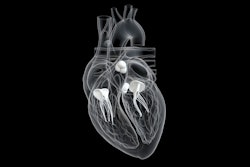A bone mineral density (BMD) assessment performed using CT imaging data is an effective way to identify, track, and support treatment of osteoporosis in men -- a patient population that tends not to get this kind of screening, researchers have found.
A team led by Tony Keaveny, PhD, of the University of California, Berkeley, reported that both men and women diagnosed with osteoporosis via a virtual, biomechanical CT (BCT) BMD tool benefitted from drug treatment to prevent hip fractures. The study results were published June 11 in the Journal of Bone and Mineral Research.
"We found that the reduction in risk of hip fracture associated with treatment did not differ between the sexes," Keaveny and colleagues wrote. "These results demonstrate that treating osteoporosis in patients at high risk of hip fracture should reduce the risk of hip fracture similarly in both sexes."
Previous research has suggested that osteoporosis treatment should prevent hip fracture similarly in both sexes, but because of its expense, randomized clinical trials to demonstrate that definitively "have not been performed and may never be," the group explained.
"As a result, osteoporosis testing and treatment is not as widely adopted for men as it is for women," it wrote.
Keaveny and colleagues have developed a "virtual stress test" called VirtuOst that uses data taken from CT imaging to assess BMD. Developed in the early 2000s under the auspices of startup firm O.N. Diagnostics, the tool produces bone strength measurements, a dual-energy x-ray absorptiometry (DEXA)-equivalent BMD T-score at the hip, and a volumetric BMD assessment of trabecular bone at the spine. It's covered by Medicare.
The U.S. Preventive Services Task Force (USPSTF) has not recommended men be screened for osteoporosis, but that doesn't mean they shouldn't be, Keaveny's team noted.
"Osteoporosis causes over one million bone fractures annually in the United States, hip fractures being the most serious and costly," the group explained. "About one in four hip fractures occur in men, and men have higher mortality after hip fracture than women. While the paradigm of treating women for osteoporosis to prevent fractures is well established, this is not so for men. For example, despite the availability of multiple drug treatments shown in randomized clinical trials to reduce risk of hip fracture in women, no such evidence exists for men -- not because of any failed trials but because such trials have not been conducted. Due in part to this lack of evidence, the [USPSTF] does not recommend diagnostic screening of osteoporosis for men. As a result, many men at high risk of osteoporotic fractures go untested and untreated for osteoporosis."
The group conducted a study that included data from 11,461 patients in the Kaiser Permanente healthcare system in Southern California ages 65 or older who had a CT scan that included visualization of the hip between 2005 and 2018 (7,913 women and 3,548 men). Out of the dataset, the group selected individuals who had a first hip fracture after the CT scan and an equal number of sex-matched, randomly selected patients (2,413 women and 792 men).
Keaveny and colleagues analyzed all who tested positive for osteoporosis (that is, with a DEXA-equivalent hip bone mineral density T-score equal to or less than -2.5, measured using VirtuOst) and tracked who were treated (they defined "treated" as at least six months of any osteoporosis medication by prescription fill during a two-year follow-up period and "not-treated" as no prescription fill). They then calculated sex-specific odds ratios of hip fracture for treated versus not-treated patients, adjusting for age, BMD T-score, BMD treatment, body mass index (BMI), race and ethnicity, and other risk factors such as alcohol dependence, smoking, diabetes, and rheumatoid arthritis.
At two-year follow-up, 33.9% of the women (750 out of 2,211) and 24% of the men (175 of 728) were treated, primarily with the drug alendronate; 51.3% and 66.3%, respectively, were not treated; and 721 and 269, respectively, had a first hip fracture since the CT scan. The team found a comparable odds ratio for both women and men of hip fracture for treated versus not treated, at 0.26 for women and 0.21 for men, and noted that "sensitivity and stratified analyses confirmed these trends, including results at five-year follow-up."
Keaveny and colleagues hope the study results will change how men are managed for osteoporosis.
"We did not address cost-effectiveness of diagnostic screening and treatment for men, nor what is the optimal way to define 'high-risk' for initiating treatment for either sex," they wrote. "Nonetheless, our study does provide more conclusive evidence, particularly when also considering the accumulated literature, that osteoporosis treatment in clinical practice prevents hip fractures similarly in high-risk men and women, whether 'high-risk' is defined by DEXA, [the Fracture Risk Assessment Tool, or FRAX], or BCT. Given the devastating effects of hip fracture, especially for men, clinical guidelines for osteoporosis testing and treatment should be updated to reflect this new evidence."
The complete study can be found here.
Disclosure: Keaveny is chief science officer at O.N. Diagnostics, the maker of VirtuOst. Study co-authors David Lee, PhD, and David Kopperdahl, PhD, have equity interests in the company.




















